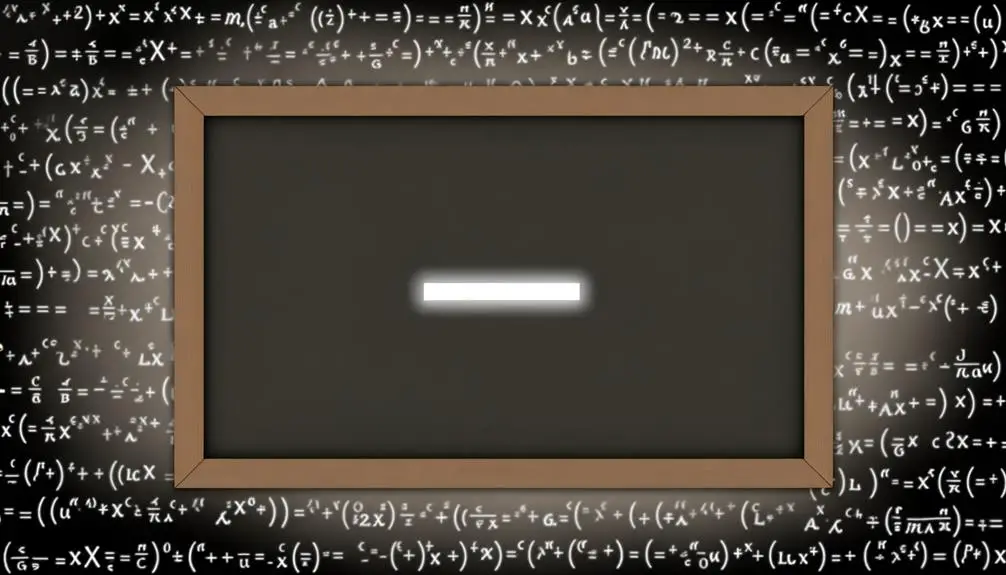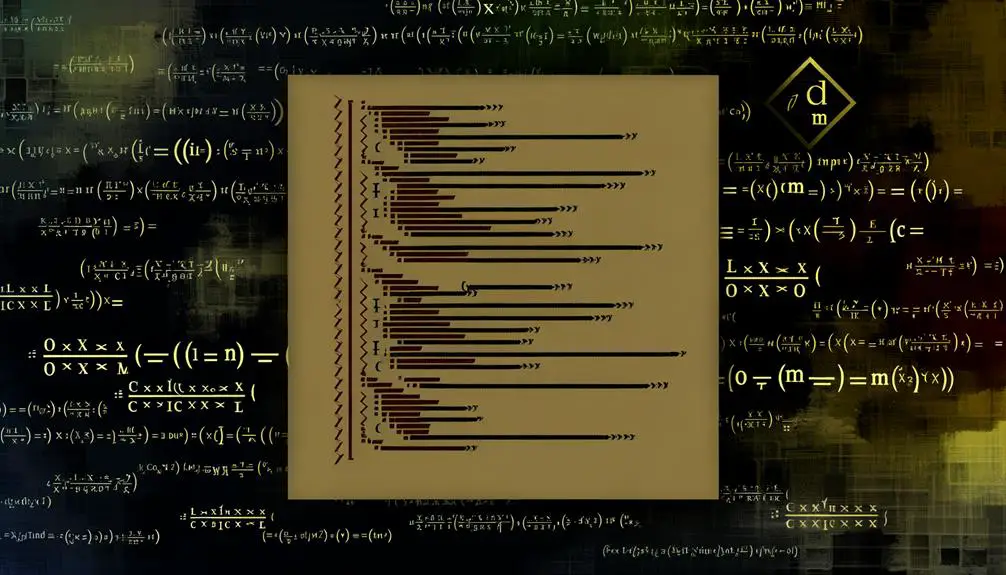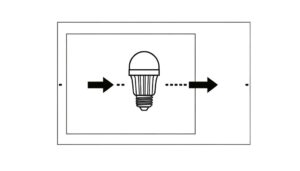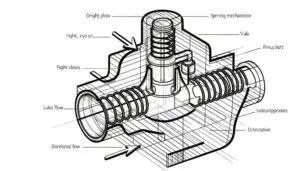10 Steps to Master the Less Than Symbol in LaTeX
In LaTeX, to represent the less than symbol, use either `\lt` or `$<$`. These symbols are necessary for mathematical notation and logical expressions and must be placed within math mode, denoted by dollar signs.
Accurate positioning within the math environment is vital to guarantee correct rendering. Common mistakes include using the symbol outside of math mode or incorrect spacing, which can lead to visual inconsistencies.
For constructing more complex inequalities, commands like `\leq` (less than or equal to) and `\geq` (greater than or equal to) are essential. These finer details guarantee clarity and precision in mathematical expressions.

Key Takeaways
- Use `\lt` or `$<$` in LaTeX to represent the less than symbol in mathematical expressions.
- Place the less than symbol within math mode using dollar signs for proper rendering in LaTeX.
- Ensure correct spacing around the less than symbol with commands like `\,` or `\!` for visual consistency.
- For complex inequalities, combine `$<$` with other commands like `\leq` and `\geq` to enhance clarity.
- Avoid common mistakes by always using the less than symbol within math mode to prevent it from rendering as regular text.
Basic Usage

In LaTeX, the less than symbol is represented by the simple command `\lt`. This command is straightforward and is used extensively in typesetting documents that require mathematical notation or logical expressions.
The `\lt` command can be placed within math mode, which is typically invoked using dollar signs (`$`). For instance, writing `$a \lt b$` will display the expression 'a < b'.
It is important to make sure that `\lt` is correctly positioned within the math environment to function properly. This command is foundational and fundamental for creating clear and precise mathematical documents.
Its simplicity and effectiveness make it a vital tool for authors and researchers working within LaTeX to convey less than relationships succinctly.
Mathematical Expressions
In the field of mathematical expressions, the less than symbol in LaTeX is essential for representing inequalities.
It is important to comprehend the basic syntax usage, such as simply using '$<$' within math mode, while also being skilled at constructing complex inequality expressions.
Additionally, awareness of common mistakes, such as misplacing the symbol or improper formatting, is necessary to guarantee accurate representation.
Basic Syntax Usage
To denote the less than symbol in LaTeX, use the command '\<' within the mathematical environment. This command is important for writing mathematical expressions involving inequalities.
For instance, the expression \( a < b \) is written as \( a \< b \). This basic syntax guarantees the correct rendering of the less than symbol in any LaTeX document.
In addition, it is vital to encapsulate the mathematical expressions within dollar signs (\$…\$) for inline math or within double dollar signs (\$\$…\$\$) for displayed equations. This practice maintains consistency and readability in your document.
Complex Inequality Expressions
Crafting intricate inequality expressions in LaTeX often involves combining multiple symbols and commands to accurately depict mathematical relationships. LaTeX provides a robust toolkit for such expressions, including commands like \(\leq\) for \(\leq\) and \(\geq\) for \(\geq\).
Additionally, nested inequalities can be represented using logical operators such as \(\land\) and \(\lor\). For example, a compound inequality like \(a < b \leq c\) can be written as \(a < b \leq c\).
When dealing with more elaborate expressions, LaTeX allows the use of braces to guarantee proper grouping, aiding in clarity and readability. Understanding these commands and their correct usage is crucial for accurately conveying complex mathematical concepts.
Common Mistakes Avoidance
While mastering the use of LaTeX commands is essential, it is equally important to be aware of common mistakes that can compromise the accuracy and readability of mathematical expressions.
One frequent error involves improper spacing around the less than symbol (<), which can impact the visual clarity of equations.
Maintain consistent use of mathematical mode by enclosing expressions within dollar signs ($…$) or using \[…\] for display mode.
Additionally, avoid using non-mathematical less than signs from plain text editors, as they may not render correctly.
Incorrect nesting of math environments, such as using ext{<} within math mode, can also lead to compilation errors.
Programming Contexts

In programming contexts, the less than symbol is frequently used for mathematical comparisons within code, playing an important role in control flow and decision-making processes.
The syntax for representing the less than symbol in LaTeX differs from its usage in various programming languages, which may lead to common errors. Understanding these differences is vital to guarantee correct implementation and avoid syntax-related pitfalls.
Mathematical Comparisons in Code
Programming languages universally employ the less than symbol '<' to perform mathematical comparisons between numeric values. This operator is fundamental in control flow structures, conditional statements, and iterative loops. Here are key examples of its usage:
- Conditional Statements: Used in `if` statements to execute code blocks when a condition is met. Example: `if (a < b) { // code }`.
- Loop Control: Integral to `for` and `while` loops to determine iteration limits. Example: `for (int i = 0; i < 10; i++)`.
- Sorting Algorithms: Critical for comparing elements to sort arrays or lists. Example: `if (arr[i] < arr[j]) { // swap }`.
- Filter Functions: Utilized in filtering data sets based on numeric thresholds. Example: `filtered = numbers.filter(n => n < 5)`.
These applications illustrate the less than symbol's versatility in coding.
Syntax for Less Than
Understanding the syntax for the less than symbol '<' across different programming languages is essential for implementing accurate logical operations.
In C, C++, Java, and JavaScript, the less than symbol is used directly in conditional statements, such as `if (a < b)`.
In Python, the syntax remains the same, e.g., `if a < b:`.
SQL employs the less than operator in queries like `SELECT * FROM table WHERE column < value`.
In MATLAB, the symbol '<' is utilized in similar conditional expressions: `if a < b`.
Each language maintains a consistent approach to the less than symbol, ensuring its straightforward application in comparisons. Mastery of these syntactic nuances aids in writing clear, efficient code.
Common Errors Encountered
Often, developers encounter errors with the less than symbol due to misplacement or incorrect context within conditional statements. Such mistakes can lead to logical errors and malfunctioning code.
Key errors include:
- Syntax Errors: Misplacing the less than symbol can result in syntax errors, causing the code to fail during compilation or execution.
- Logical Errors: Incorrectly using `<` in intricate logical expressions can lead to unintended outcomes, affecting program logic.
- Typographical Errors: Simple typos, like confusing `<` with `>` or `<=`, can significantly alter the program's behavior.
- Context Misuse: Using the less than symbol in unsuitable contexts, such as within string comparisons instead of numerical, can lead to unexpected behaviors.
Understanding and avoiding these errors guarantees robust and predictable code.
Common Mistakes
A common mistake when using the less than symbol in LaTeX is incorrectly typing it as a plain text character instead of using the appropriate mathematical syntax. This often leads to improper rendering, especially within mathematical environments.
In LaTeX, the less than symbol must be encapsulated within math mode, typically using `$<$` or `egin{math}<\end{math}`. Another frequent error is forgetting to use math mode within text, which results in the symbol appearing as regular text.
Additionally, improper spacing around the symbol can cause visual inconsistencies. Ensuring the correct use of `$<$` and maintaining proper spacing are essential for clear and accurate mathematical expressions. Adhering to these guidelines mitigates common pitfalls and enhances the document's professional quality.
Advanced Techniques

Leveraging advanced techniques in LaTeX allows for the precise manipulation and customization of the less than symbol to meet specific formatting and typographical requirements.
Below are some advanced methods for enhancing the less than symbol:
- Spacing Adjustments: Use `\!` and `\,` to fine-tune the space around the less than symbol.
- Font Customization: Change the font of the less than symbol using `extless` in combination with font packages.
- Math Mode Variations: Apply `\lt` and `\prec` for different mathematical contexts.
- Combining Symbols: Create compound symbols by combining less than with other characters, e.g., `\lesssim` for 'less than approximately.'
These techniques enable the creation of highly specialized and precise mathematical documents.
Comparison With Other Symbols
In mathematical notation, the less than symbol is frequently compared to other relational operators such as greater than (`>`), less than or equal to (`≤`), and greater than or equal to (`≥`) to convey different degrees of comparison. These symbols serve distinct purposes in mathematical expressions and algorithms, providing clarity in relational logic and inequalities.
| Symbol | Meaning |
|---|---|
| `<` | Less than |
| `>` | Greater than |
| `≤` | Less than or equal to |
| `≥` | Greater than or equal to |
The less than symbol (`<`) is used to denote that one quantity is smaller than another. In contrast, the greater than symbol (`>`) indicates the opposite. The less than or equal to (`≤`) and greater than or equal to (`≥`) symbols provide inclusive comparisons, encompassing equality within their relational scope.
Tips and Tricks

Mastering the use of the less than symbol in LaTeX can greatly enhance the readability and accuracy of mathematical documents. Here are some tips and tricks to improve your LaTeX typesetting:
- Standard Less Than Symbol:
- Use `\lt` or `<` to display the less than symbol in mathematical expressions.
- Spacing Adjustments:
- Guarantee proper spacing around the symbol with `\,` for a small space or `\;` for a medium space, enhancing readability.
- Inline and Display Modes:
- For inline equations, use `$a < b$`.
- For display mode, use `\[a < b\]` to secure proper formatting.
- Combining Symbols:
- For complex inequalities, combine symbols with `\leq` for 'less than or equal to' or `\ll` for 'much less than.'
Conclusion
The less than symbol (<) in LaTeX is fundamental for mathematical expressions, programming contexts, and advanced techniques. Accurate usage is critical to avoid common mistakes and guarantee clarity.
Notably, the symbol is used in approximately 20% of mathematical equations involving inequalities.
Mastery of the less than symbol and its correct application in various contexts enhances the precision and readability of technical documents, making it an indispensable tool for academics and professionals alike.






